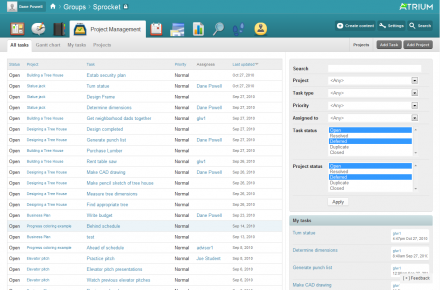 Support for Drupal 7 is ending on 5 January 2025—it’s time to migrate to Drupal 10! Learn about the many benefits of Drupal 10 and find migration tools in our resource center.
Support for Drupal 7 is ending on 5 January 2025—it’s time to migrate to Drupal 10! Learn about the many benefits of Drupal 10 and find migration tools in our resource center.This project is not covered by Drupal’s security advisory policy.
A feature-based version of Case Tracker, which relies much more heavily on standard Drupal modules like CCK and Comment Driven, and is thus much more extensible. Contains nearly 100% of the functionality of Case Tracker, and then some, with Gantt charts, progress and duration fields, and task dependencies out-of-the-box. Included submodules provide Open Atrium integration and migration from Case Tracker and Storm environments.
This Feature provides two new content types (Task and Project) replete with CCK fields such as "Progress", "Duration", etc... and several Views of tasks and projects, including a Gantt chart. It styles the CCK fields on Tasks and Projects in a way that can easily accommodate new custom fields, and allows these fields to be updated via comments.
Please note that despite the high version number, this project is still early in development. Many people (including myself) have found it to be a perfectly usable replacement for CaseTracker, while others have had quite a few problems that remain to be solved.
Be sure to refer to the included INSTALL.txt and README.txt.
Status / Future of CT Plus
CT Plus has turned out to be an interesting experiment, but I'm not clear on a way forward for the project, as long as Driven (one of its primary dependencies) will not have a D7 port. Additionally, I don't want to split attention with the original Casetracker project- I'd like to see the efforts of Casetracker and CT Plus merge. If you are willing to fund and/or coordinate the efforts of CT Plus, Casetracker, Driven, and Open Atrium (the leading user of Casetracker), I would be very interested in pursuing that. Otherwise, I'm afraid I have no plans for future development.
I suppose you could consider this a wishlist of features:
- #1000464: Improve documentation
- #995092: Comparison with the CT2 Plans
- #997282: Move Spaces dependency (and other OA-specific features) to OA CT Plus
- Drupal 7 port - note that the biggest blocker for a D7 port is the required Driven package, which will likely need to be completely rewritten for D7. You can check on progress at #994240: Port Driven API to Drupal 7
- "QuickComment" or "QuickEdit" feature - this would allow you to (for instance) quickly change a task's status from the task list by using AJAX to display the comment or edit form for a task.
- Improved Gantt charting - the current Gantt chart solution is expensive (in CPU/resource terms) and doesn't scale well. I'd like to replace this with a solution that has more features and allows inline editing of tasks
Customizing CT Plus
The primary advantage of this module over Case Tracker (at least in my mind) is that it uses standardized "lego" construction, using CCK fields, content types, and other "exportables" or "faux-exportables", which can be altered by site developers to suit their own needs. Traditionally, if you want to make changes to a module, you hack the module code locally and then reconcile the changes you've made with changes the module developer makes in future releases - this is known as vendor branching, and is tedious and error-prone. Features makes this process easier by allowing site developers to maintain those changes in modules of their own, rather than by directly hacking the module of interest. This means that you can make a module that will override almost any component of CT Plus, including adding new fields, changing the allowed values of fields, etc...
The learning curve on this can be a bit steep, and I'm afraid I won't always be able to help, so I'd suggest using the following resources:
- Guide to customizing Atrium - CT Plus is not directly related to Atrium, but both are distributed as Features, and thus the principles behind how to customize them are the same.
- Features project page - There are some links to readme and API files. You can try using the issue queue as well. Unfortunately, there's not great documentation on how to customize Features distributed by others - the best guide I've found is the Atrium guide above. If you have as frustrating of an experience as I did learning how to customize features, you might consider egging on the maintainers to improve the documentation, or write it yourself!
Project information
Unsupported
Not supported (i.e. abandoned), and no longer being developed. Learn more about dealing with unsupported (abandoned) projectsNo further development
No longer developed by its maintainers.2 sites report using this module
- Created by Dane Powell on , updated
This project is not covered by the security advisory policy.
Use at your own risk! It may have publicly disclosed vulnerabilities.












